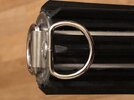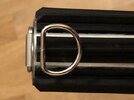uglyguitarguy
Active Member
Assuming that the side rivets were indeed remnants of an attempt to install a d-ring bracket, then why FOUR rivets? Does that mean two separate, failed attempts? One attempt, but with an excessive amount of rivets?
Also, since the Elstree saber had ANH hero traits, no side rivets, and indications of an attempt to install an FX blade holder (or something) on the upper, that makes me think the Elstree was a failed attempt at an FX made after the hero design (with the d-ring mounted on the endcap) had been finalized.
Those are good questions, and the other one has to do with the different rivet sizes in the vertical direction. That means that they were likely drilled and riveted vertically, not horizontally, on separate occasions. Otherwise, why would they be different (other than by complete chance)? If they were drilled vertically (and they are quite close together in that direction), then the D-ring concept also falls apart. Horizontally they're also much wider apart than the rivets on the bottom D-ring clip, so the only hypothesis that supports horizontal is that they were trying to attach the D ring without the clip. If they drilled and riveted the holes vertically at separate times, then we've really gotta go back to the drawing board about what they would be there for...


